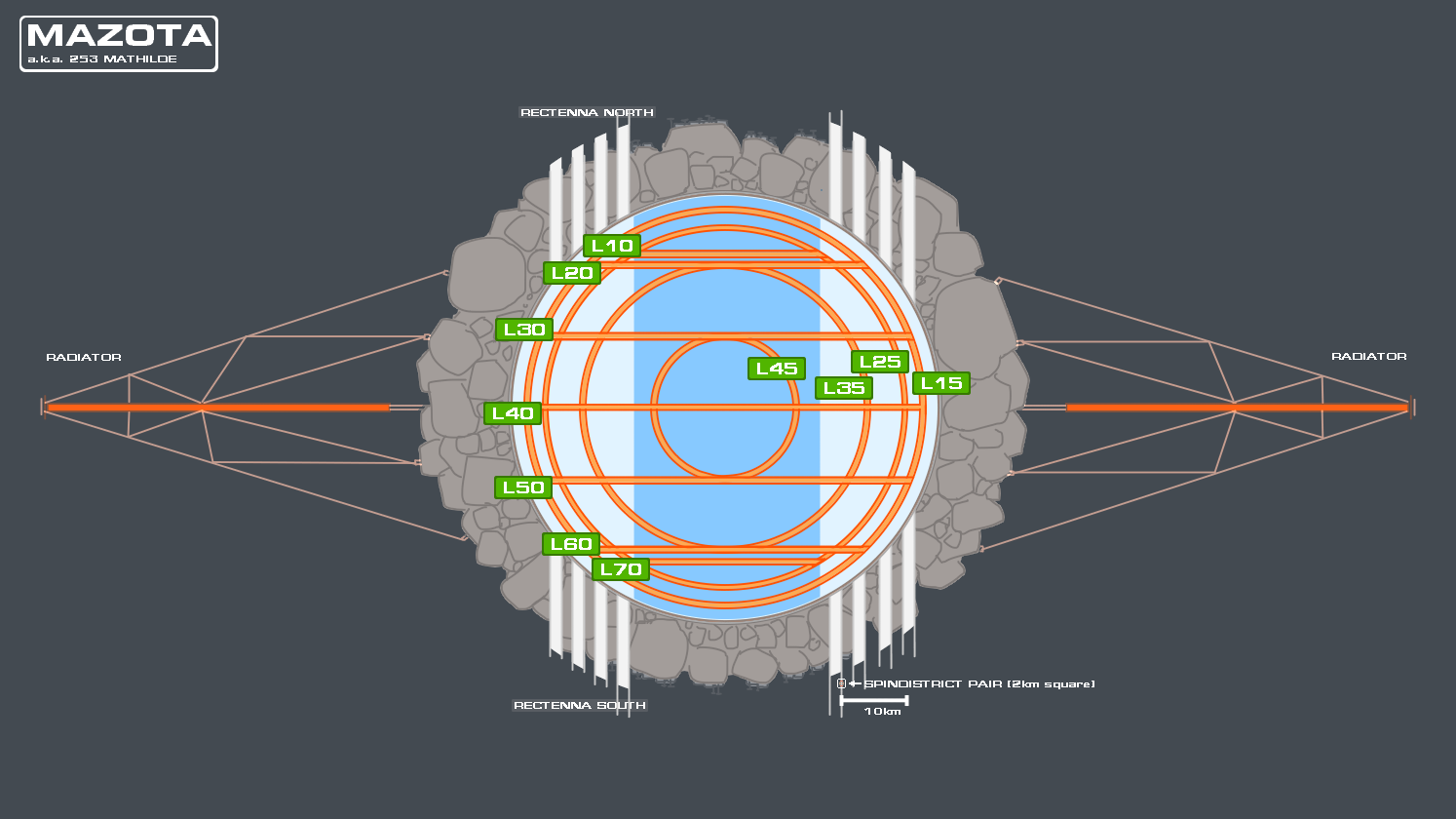Gravitational Balloons, Sealed Caverns
Inflatable habitat technology played a minor role in the early days of space travel, but engineers and science fiction authors had begun to realize its potential by the late 20th century and a slow brew of ideas and demonstrator technology emerged in the early decades of the 21st. The TransHab technology developed by NASA, though stymied by political obstacles and sold off to a private developer, began to come into its own by the 2010s with miniature versions followed by the BEAM human habitat demonstrator docked to the International Space Station.
On Earth, a more epic vision of inflatable habitats was elaborated by Karl Schroeder with Virga, a planet-sized balloon filled with breathable air and asteroids. Such a balloon obviously could not be built with near-future technologies of the time, but it inspired further analysis of balloon concepts by Alan R, who developed the concept into what he called the gravitational space balloon.
Gravity balloons, as the name implies, are air-filled balloons held stable against their internal pressure by the self-gravitation of billions of tonnes of asteroid rock. They can be built inside asteroids ranging roughly from 10 to 70 kilometers in diameter, corresponding to maximal population counts (assuming roughly transhuman-style build and accommodations) of 20 million to 2 billion at full urbanization. Such population densities, outstripping the usual limits of planetary urbanization by orders of magnitude, can be thought of as "stacking" the equivalent of a large planetary city many times over.
The general spirit of the gravity balloon can also be extended more generally to the sealed-cavern habitat. SCH's are an extremely common type of habitat that can be built into large asteroids and offers much more flexible scaling than a gravity balloon, whose initial investment makes them a project usually undertaken by already-wealthy polities. SCH habitats are built at a depth below the surface of a large asteroid where the pressure of the surrounding cavern walls themselves are capable of supporting a habitable atmosphere of pressure. Using regolith to plug the gaps where necessary, airwalls can be set up around small sections of cavern and expanded out as necessary. In the long run, SCH-type cities actually are capable of greater expansion than a gravity balloon, depending on the cavern content of the asteroid - the largest chondrite asteroids (>100km diameter) are, at least volume-wise, capable of housing the equivalent of hundreds of billions' of people worth of city.
Spindistricts
500-meter urban centrifuge-neighborhoods - the general term for such structures is Spindistricts - possess natural heat rejection capacity sufficient to generally maintain agreeable conditions for 20,000 transhumans. Spindistricts are usually connected in pairs that torque in opposite directions against the connecting superstructure, gaining rotational momentum while canceling out each others' net spin, and such a spindistrict pair holds 40,000 people; a maximal gravity balloon, in turn, measures about 40 spindistricts in diameter in all directions. Aside from housing, spindistricts' enormous size and rotational momentum also makes them primary engines for manipulating airflow inside large microgravity habitats. Each cylinder serves as a centrifugal pump, sucking in air through one open hub and out the opposite; while the counter-rotating twin cylinders of a spindistrict pair create a net directional airflow (and, if untethered, thrust) through the gap between the districts. Large-scale arrangements of spindistricts are used by urban planners to guide the flows of air and heat around the global interior. Well-planned spindistrict clusters can fine-tune a habitat's climate to a variety of needs. Poor arrangements and oversight may contribute to undesired weather patterns, heat buildup, and accumulation of pollution.Construction
Earthmoving
A significant portion of the investment in a typical gravity balloon or sealed cavern goes into earthmoving. During the inflation and general construction processes, crawlers, walkers, and other engineering vehicles are required to stabilize the large boulders and regolith shifts and prevent damaging large-scale oscillations, burial, or wear on equipment. Additionally, ensuring a snug seal over the balloon or airwall itself in order to prevent sections of the balloon from squeezing out through the cracks and putting the habitat at risk of a rupture requires packing regolith tightly into the gaps between larger boulders and hills, which demands strip mining from the surface and hauling down the caverns.Gravity balloons: specifics
Balloon superstructure
Balloons are typically manufactured with heavy use of aramid fiber composites such as Nyex. Unlike many large structures, gravity balloons do not require exotic carbon allotropes. Despite this, they are still a relatively heavy initial investment due to the material tolerances involved and sheer amount of balloon required. Gravity balloons are designed to be inhabited from early on in their inflation process. During initial construction, after fitting the early tunnel interfaces with the outside of the asteroid and spaceport, the balloon envelope is quickly pumped to a stable minimum size and near-hyperbaric breathable air pressure of ~3 bar, using breathing mixture supplemented with helium.Remove these ads. Join the Worldbuilders Guild










Comments